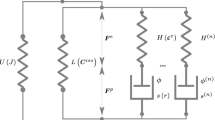Abstract
Constitutive equations for finite elastic-plastic deformation of polymers and metals are usually formulated by assuming an isotropic relation between the Jaumann rate of the Cauchy-stress tensor and the strain-ratetensor. However, the Jaumann-stress rate is known to display spuriousnon-physical behaviour in the elastic region. Replacing the Jaumann-stress rate by a Truesdell-stress rate results in an adequate description in the elastic region, but gives rise to a volume decrease during plastic flow intensile deformation. In this paper a ’’compressible-Leonov model‘‘ is introduced, in which the elastic volume response is rigorously separated from the elasto-viscoplastic isochoric deformation. This has the advantage that the model can be extended in a straightforward way to include aspectrum of relaxation times. It is shown that in the limit of small elastic strains, the compressible Leonov model reduces to the Jaumann-stress rate model, but diverges from the Truesdell-stress rate model. Finally, a comparison is made of the above mentioned models in ahomogeneous uniaxial tensile test and a homogeneous plane-stress sheartest, using polycarbonate (PC) as a model system. All models considered in this paper are ’’single mode‘‘ models (i.e. one relaxation time), and, therefore, cannot describe the full (non)linear viscoelastic region, northe strain-hardening or strain-softening response.
Similar content being viewed by others
References
Argon, A.S., ‘A theory for the low-temperature plastic deformation of glassy polymers’, Phil. Mag. 28, 1973, 839–865.
Arruda, E.M., ‘Characterization of the strain hardening response of amorphous polymers’, Ph.D. Thesis, Massachusetts Institute of Technology, 1992.
Astarita, G. and Marrucci, G., Principles of Non-Newtonian Fluid Mechanics, McGraw-Hill, London, 1974.
Baaijens, F.T.P., ‘Calculation of residual stresses in injection molded products’, Rheol. Acta 30, 1991, 284–299.
Beris, A. and Edwards, B., ‘Poisson bracket formulation of incompressible flow equations in continuum mechanics’, J. Rheol. 34, 1990, 55–78.
Besseling, J. and van der Giessen, E., Mathematical Modelling of Inelastic Deformations, Chapman & Hall, London, 1994.
Bird, R., Armstrong, R. and Hassager, O., Dynamics of Polymeric Liquids, Vol. 1: Fluid Mechanics, John Wiley & Sons, New York, 1987.
Boyce, M.C., Parks, D.M. and Argon, A.S., ‘Large inelastic deformation of glassy polymers, Part 1: Rate dependent constitutive model’, Mech. Mater. 7(1), 1988, 15–33.
Coleman, B. and Noll, W., ‘The thermodynamics of elastic materials with heat conduction and viscosity’, Arch. Rational Mech. Anal. 13, 1963, 167–178.
Grmela, M., ‘Stress tensor in generalized hydrodynamics’, Phys. Lett. A 111, 1985, 41–44.
Hasan, O.A., Boyce, M.C., Li, X.S. and Berko, S., ‘An investigation of the yield and postyield behaviour and corresponding structure of poly(methyl methacrylate)’, J. Polym. Sci. Polym. Phys. Ed. 31(2), 1993, 185–197.
Haward, R.N. and Thackray, G., ‘The use of mathematical model to describe isothermal stress-strain curves in glassy polymers’, Proc. Roy. Soc. A 302, 1968, 453–472.
Hunter, S.C., Mechanics of Continuous Media, 2nd edn, Ellis Norwood, Chichester, 1983.
James, H.M. and Guth, E., ‘Theory of the elastic properties of rubber’, J. Chem. Phys. 11, 1943, 455–481.
Jongschaap, R., ‘Microscopic modelling of the flow properties of polymers’, Rep. Prog. Phys. 53, 1990, 1–55.
Jongschaap, R.J.J., de Haas, K.H. and Damen, C.A.J., ‘A generic matrix representation of configuration tensor rheological models’, J. Rheol. 38, 1994, 1–28.
Krausz, A. and Eyring, H., Deformation Kinetics, Wiley-Interscience, London, 1975.
Larson, R.G., Constitutive Equations for Polymer Melts and Solutions, Butterworth, Stoneham, 1988.
Leonov, A.I., ‘Nonequilibrium thermodynamics and rheology of viscoelastic polymer media’, Rheol. Acta 15, 1976, 85–98.
Neale, K., ‘Phenomenological constitutive laws in finite plasticity’, Solid Mech. Arch. 6, 1981, 79–98.
Rubin, M.B., ‘Plasticity theory formulated in terms of physically based microstructural variables. Part 1. Theory’, Int. J. Solids Structures 31(19), 1994, 2615–2634.
Sansour, C. and Bednarczyk, H., ‘A study on rate-type constitutive equations and the existence of a free energy function’, Acta Mech. 100, 1993, 205–221.
Simo, J., Taylor, R. and Pister, K., ‘Variational and projection methods for the volume constraint in finite deformation elasto-plasticity’, Computer Meth. Appl. Mech. Engng. 51(1–3), 1985, 177–208.
Tervoort, T.A., Klompen, E.T.J. and Govaert, L.E., ‘A multi-mode approach to finite, nonlinear viscoelastic behaviour of polymer glasses’, J. Rheol. 40(5), 1996, 779–797.
Tobolsky, A.V. and Eyring, H., ‘Mechanical properties of polymeric materials’, J. Chem. Phys. 11, 1943, 125–134.
van Wijngaarden, H., ‘Constitutive relations for metals with an application to the extrusion of lead’, Ph.D. thesis, Eindhoven University of Technology, Eindhoven, the Netherlands, 1988.
Ward, I.M., Mechanical Properties of Solid Polymers, 2nd edn, John Wiley & Sons, Chichester.
Whitney, W. and Andrews, R.D., ‘Yielding of glassy polymers: Volume effects’, J. Pol. Sci. C 16, 1967, 2981–2991.
Wu, P.D. and van der Giessen, E., ‘On improved network models for rubber elasticity and their applications to orientation hardening in glassy polymers’, J. Mech. Phys. Solids 41, 1993, 427–456.
Author information
Authors and Affiliations
Rights and permissions
About this article
Cite this article
Tervoort, T., Smit, R., Brekelmans, W. et al. A Constitutive Equation for the Elasto-Viscoplastic Deformation of Glassy Polymers. Mechanics of Time-Dependent Materials 1, 269–291 (1997). https://doi.org/10.1023/A:1009720708029
Issue Date:
DOI: https://doi.org/10.1023/A:1009720708029




